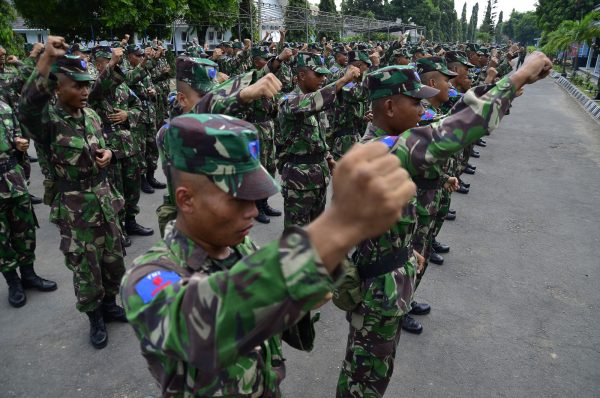
After the end of the Cold War, and particularly following the victory of the United States-led coalition in the Gulf War, American defense experts began to theorize that a “revolution in military affairs” (RMA) had occurred. They believed that the utilization of new technologies and extensive battlefield information processing capacity had significantly contributed to the coalition’s victory against Iraq, which was by no means an insignificant power at the time.
The RMA concept then briefly lost momentum in the early 21st century with the rise of asymmetrical warfare. However, with recent technological advancements and the resurgence of interstate and high-intensity conflicts, these questions arise: is it the time to revive discussions on the said concept to develop an “RMA 2.0”? How should Indonesia adapt to these changes as a country that faces significant new security challenges?
The world has recently witnessed the rise of interstate tensions. In Europe, the Russo-Ukrainian conflict, ongoing since 2014 and escalating to a full-scale war in 2022, shows no signs of resolution. Some analysts have even projected that the war could develop into a stalemate. Meanwhile, tensions continue to rise between the U.S. and China in the Indo-Pacific region, as both nations strive for influence, particularly in the South China Sea. This will demand armed forces around the world to refine their strategies after years of focus on asymmetrical warfare and counterinsurgency operations.
Technological advancements also add weight to the situation. Drone warfare during the 2020 Armenia-Azerbaijan War led observers to expect that drone usage would define the future of warfare. Moreover, non-state actors are also utilizing new assets and methods. For instance, the Houthis in Yemen have used drones and anti-ship missiles to disrupt commercial traffic in the Red Sea. With these developments in mind, Indonesia must adapt to the evolving security context by bolstering its defense capabilities in order to safeguard its sovereignty.
When it comes to strengthening a nation’s military power by procuring new military assets, Indonesia is not short on initiatives. The country has signed contracts to acquire Airbus A400M transport aircraft and Rafale fighter jets. Indonesia is also involved in the ongoing joint development of the KF-21 Boramae fighter jet with South Korea and recently signed a contract for the procurement of two Scorpene Evolved submarines. These initiatives will likely enhance Indonesia’s firepower and power projection capability.
However, it is important to remember that a superior defense capability is not solely about possessing a sizable quantity of assets and technology – a common misconception among amateur defense enthusiasts. Ideally, doctrine adaptation should go hand-in-hand with procurement initiatives to maximize the effectiveness of a country’s military assets.
This is where the notion of collaborative combat comes into play. Similar to the RMA, this principle emphasizes the importance of gaining an upper hand in battlefield information processing capacity, which can be used by all military assets in a given battlespace. For instance, one asset can feed information to other assets, hence enhancing overall situational awareness. This integrative approach would clearly benefit Indonesia, with its heterogeneous range of theaters, which include urban areas, rainforests, open oceans, and “brown water” bodies (e.g. lakes and rivers).
Collaborative combat also highlights interconnectivity between diverse defense assets and systems, particularly in the information technology sphere. In particular, this aims to enhance the operational effectiveness of various assets through an integrated command and control system. In this manner, collaborative combat can ultimately minimize both human and material losses while accomplishing its missions.
As Indonesia operates platforms and systems from various countries, the country faces challenges in implementing the principle of collaborative combat due to potential compatibility issues. Nonetheless, Indonesia is already on a good path with the establishment of a defense industry holding, DEFEND ID, in April 2022. This initiative will allow the Indonesian defense industry to produce assets that are tailored to the country’s needs while also ensuring that they can operate within an integrated system, hence laying the groundwork for the promotion of a collaborative combat approach.
Moreover, a notable development occurred with the recent signing of the Scorpene submarine deal. Under this program, the France-based naval ship manufacturer Naval Group and PT PAL Indonesia, a subsidiary of DEFEND ID will jointly build the Scorpene submarine at the latter’s facilities in Surabaya, East Java. This partnership may open opportunities for the Indonesian defense industry to embark on similar projects, hence enhancing the country’s overall defense capabilities, converging its military systems and platforms, and no less importantly, forming an economy resilient to national security challenges or even war, when the demand for defense assets could rise significantly.
Such strategic programs also demonstrate that it is essential for the Indonesian domestic defense industry to choose its partners carefully. As a matter of fact, this “RMA 2.0” will also rely on the capacity of the defense industry to provide the Indonesian armed forces with equipment and platforms that will help the latter to fully implement the principle of collaborative combat, in order to achieve superiority over potential adversaries and to protect and defend Indonesia’s sovereign interests.
All things considered, it is time for Indonesia to recognize the fact that simply amassing a diverse kind of defense assets will not be sufficient to address the constantly evolving security challenges, if not accompanied by a defense strategy overhaul. The country should adapt its military doctrine to embrace what could become a new version of a “revolution in military affairs.” Such an initiative necessitates efforts to integrate platforms for collaborative combat, as well as to develop Indonesia’s defense industry to fulfill the country’s demands for sufficient, and suitable, military assets.
The views expressed in this article are personal.
- SEO Powered Content & PR Distribution. Get Amplified Today.
- PlatoData.Network Vertical Generative Ai. Empower Yourself. Access Here.
- PlatoAiStream. Web3 Intelligence. Knowledge Amplified. Access Here.
- PlatoESG. Carbon, CleanTech, Energy, Environment, Solar, Waste Management. Access Here.
- PlatoHealth. Biotech and Clinical Trials Intelligence. Access Here.
- Source: https://thediplomat.com/2024/06/indonesia-should-embrace-a-new-revolution-in-military-affairs/



